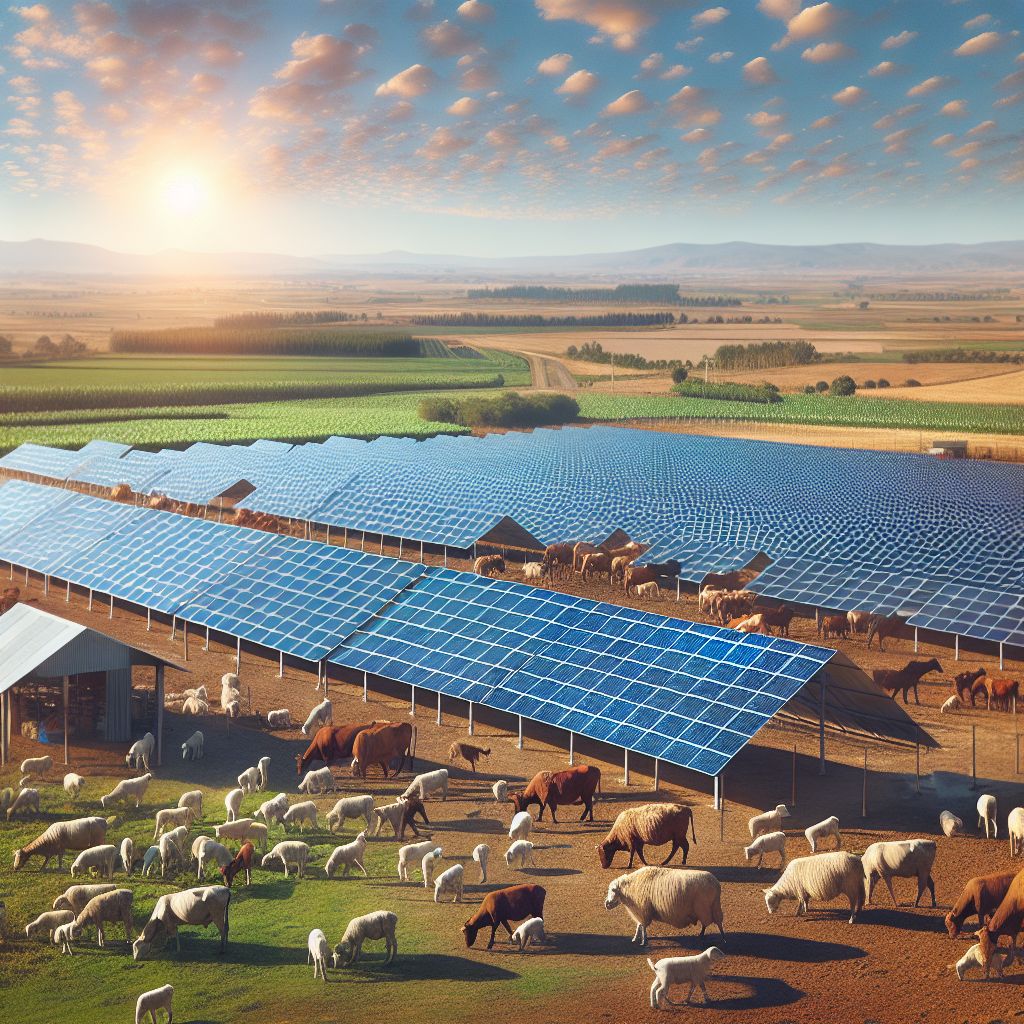
Key Takeaways
Solar panels on farms provide a comfortable and shaded environment for livestock, enhancing their well-being.
Adopting solar energy can result in significant cost savings and new income sources for farmers.
Agrivoltaics, the merger of agriculture and photovoltaics, improves land use efficiency.
Environmental benefits include a smaller carbon footprint and biodiversity support.
Real-world case studies show the effectiveness of integrating solar panels on farms.
Reaping the Sun’s Power: Solar Energy on Farms Benefits Animals
When we imagine farming, we typically picture vast fields, tractors, and livestock grazing calmly. However, there’s a potent ally from the sky that’s revolutionizing how we view agriculture: the sun. By capturing solar energy with photovoltaic panels, farmers are not only generating green energy but also creating a more comfortable setting for their livestock. This cutting-edge method is known as agrivoltaics, and it’s a game-changer for eco-friendly farming.
Grasping the Fundamentals of Solar Energy
Solar energy functions by transforming sunlight into electricity. This transformation is achieved through solar panels, which consist of numerous individual solar cells. When these cells are exposed to sunlight, they generate an electric current. This current can then power any electrical device, ranging from farm machinery to household lights. As we strive to lessen our environmental footprint, this clean, renewable energy source is growing increasingly vital.
How Renewable Energy in Agriculture Can Benefit Your Livestock
Renewable energy isn’t just about being environmentally friendly—it’s also about being animal-friendly. Incorporating solar panels on farms can result in better living conditions for livestock. For example, solar panels can provide shade for animals during the hot summer months, which can reduce heat stress and promote better health overall.
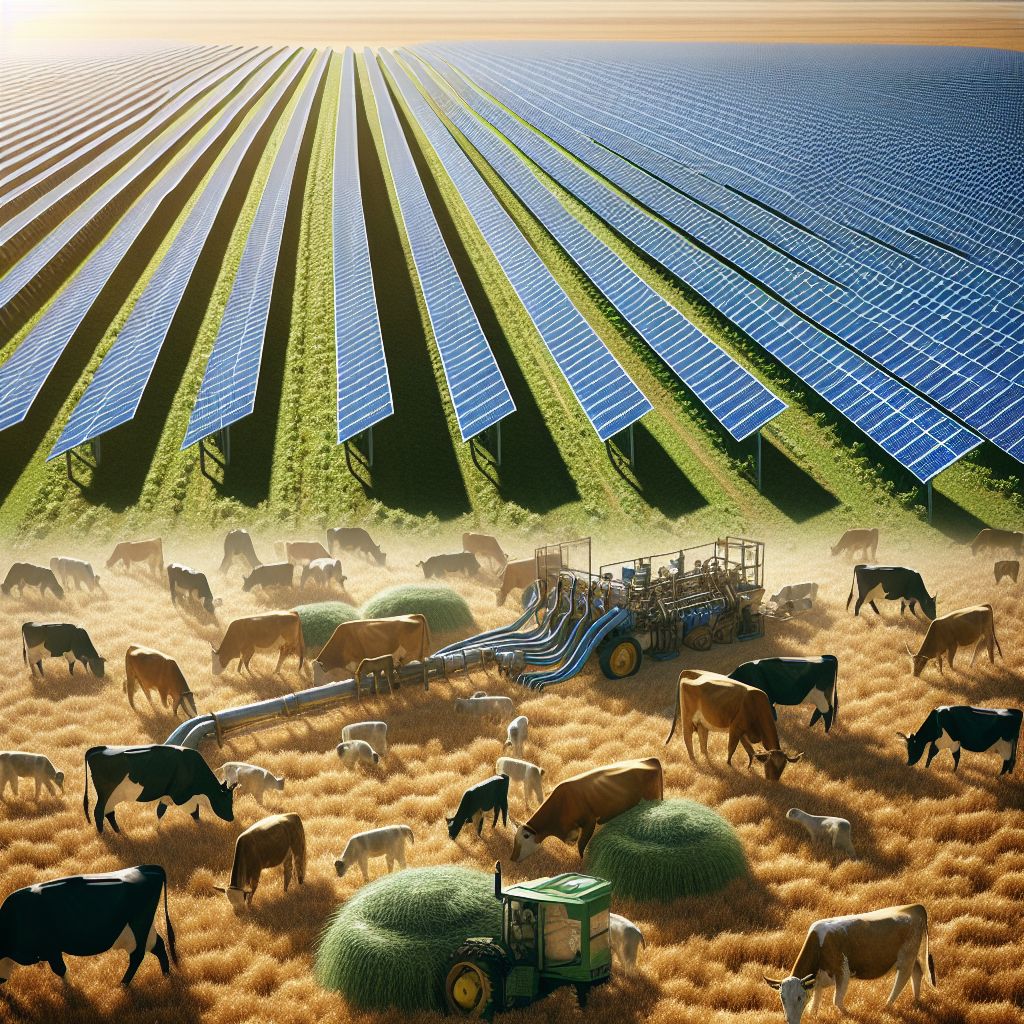
The Perfect Partnership: Solar Panels and Livestock
Now, you may be wondering, how do solar panels and livestock work in harmony? It’s all about creating a win-win situation. The solar panels offer shade and shelter, while the animals keep the grass short, ensuring the panels work at their best. This perfect partnership can result in a more content herd and a more profitable business.
Here’s how solar panels can benefit your livestock:
Shade can help animals manage heat stress, especially on hot days.
Renewable energy production can power electric fences and water pumps for livestock.
Animals like sheep that graze around solar panels can help manage vegetation growth.
Creating a Cooler Environment for Animal Comfort
Comfort is important for livestock. When animals are too hot, they eat less, produce less milk, and grow more slowly. By installing solar panels, farmers can create shaded areas where animals can get away from the heat. This not only improves their comfort but also their productivity.
Solar Panels as Shade Structures: Two Birds with One Stone
These solar panels are doing more than just generating electricity. They also serve as shade structures. By providing a cooler area, the solar panels help to decrease the risk of heat-related illnesses in livestock. This can be a major issue for farmers, as it can be both devastating and costly.
Right below is a table showing more examples how solar panels can benefit livestock:
|
Benefit |
Description |
|---|---|
|
Shade and Shelter |
Solar panels installed in pastures or near livestock facilities can provide shade and shelter for animals, helping to decrease their body temperatures during hot summer months. 1, 2, 3, 5 |
|
Reduced Energy Costs |
Generating your own solar energy on your farm can significantly reduce your energy expenses for powering livestock facilities like barns, watering systems, and other equipment. 2, 5 |
|
Additional Grazing Land |
Grazing livestock under solar panels allows you to utilize that land for forage, increasing your available pasture acres without needing to buy or rent additional land. The livestock can help maintain the vegetation under the panels. 1, 2, 5 |
|
Increased Crop Yields |
In some cases, certain cool-season crops may see increased yields when grown in the partial shade of solar panels, as the soil may retain more moisture. This can provide additional feed or forage for livestock. 5 |
|
Ecosystem Services |
Solar sites can be designed to include pollinator-friendly native plants, which can provide ecological benefits and potentially increase forage options for grazing animals. 1, 5 |
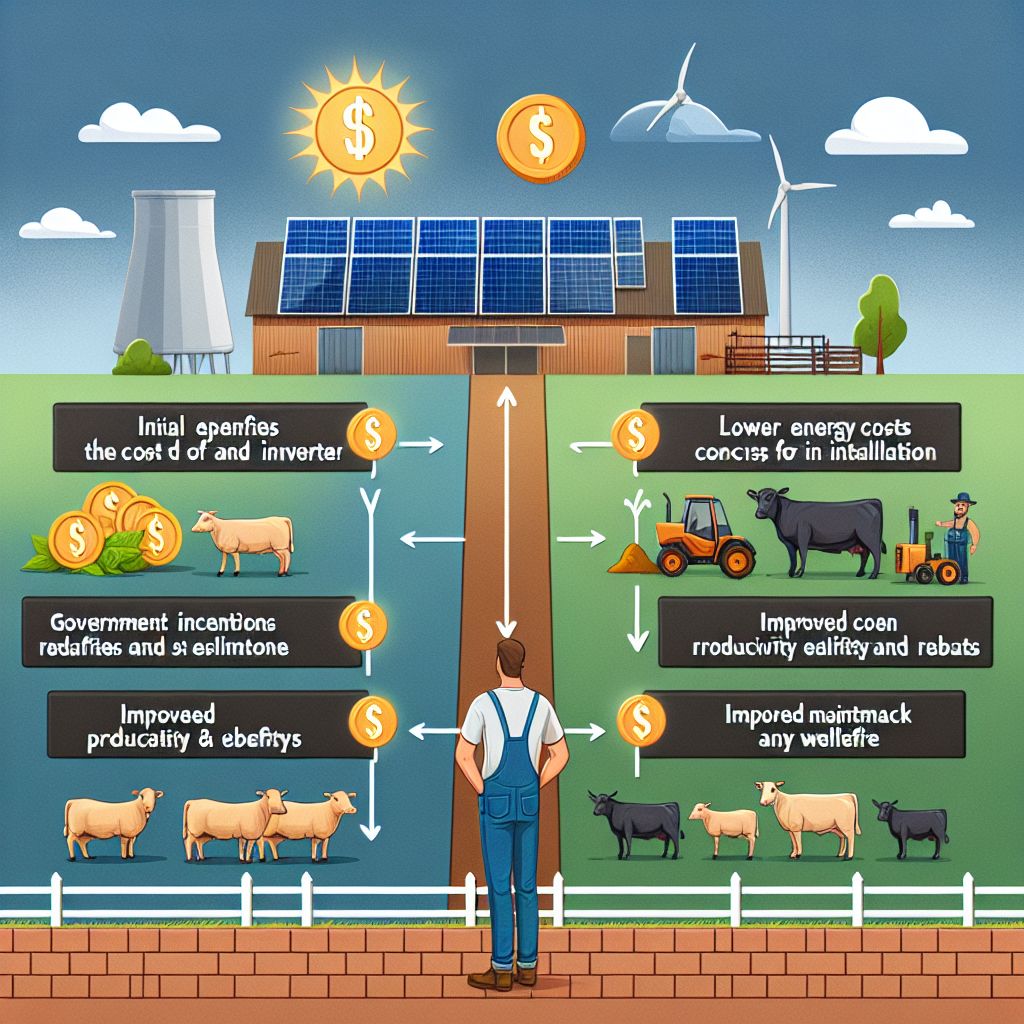
Figuring Out the Financial Benefit: Is the Investment Worthwhile?
Let’s discuss the figures. The initial expense of solar panels can be substantial, but it’s important to consider the long-term savings and potential earnings. Solar power can decrease your dependence on the grid, reduce your electric bills, and in some instances, you can even sell surplus energy back to the utility company.
Understanding the Expenses and Benefits to Your Livestock
The cost of setting up solar panels on a farm usually includes the following:
Price of solar panels and inverters
Costs of installation and labor
Expenses for maintenance and repair over time
But, these expenses are counterbalanced by:
Lower energy costs
Available government incentives and rebates
- Enhanced livestock productivity and welfare
Economic Advantages for Farmers in the Long Run
Eventually, the investment in solar panels will pay for itself. Not to mention the advantages of enhanced livestock productivity and the possibility of earning extra income from selling energy. Many farmers who have switched to solar energy are discovering that the initial cost is a wise investment in the future of their farm.
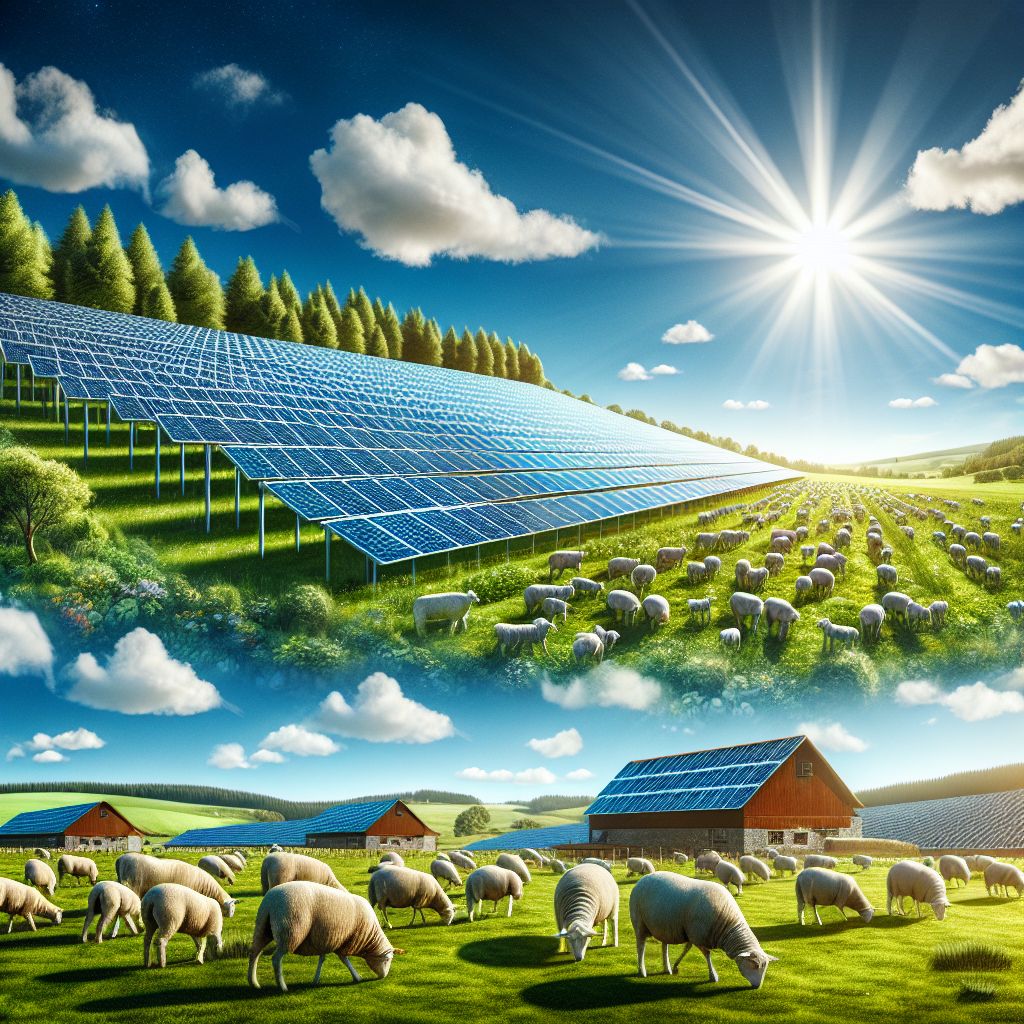
Green Farming: It’s Not Just About Saving Money, It’s Also Good for the Animals
There’s more to using solar energy on farms than just saving money. It’s about running a farm that’s sustainable and good for the environment, and that’s also good for the animals. There are many benefits, like reducing your carbon footprint and promoting biodiversity. That a look at this below table:
|
Benefit |
Description |
|---|---|
|
Sustainability and Environmental Impact |
Solar energy allows farms to reduce their carbon footprint and environmental impact by generating clean, renewable electricity instead of relying on fossil fuels. This supports more sustainable agricultural practices. 1, 3, 5 |
|
Biodiversity and Ecosystem Services |
Solar sites can be designed to include pollinator-friendly native plants, which can provide ecological benefits and potentially increase forage options for grazing animals. This promotes biodiversity on the farm. 1, 5 |
|
Livestock Welfare |
Solar panels installed in pastures or near livestock facilities can provide shade and shelter for animals, helping to decrease their body temperatures during hot summer months and improve their overall comfort and well-being. 1, 3, 5 |
|
Crop Yields |
In some cases, certain cool-season crops may see increased yields when grown in the partial shade of solar panels, as the soil may retain more moisture. This can provide additional feed or forage for livestock. 5 |
|
Integrated Land Use |
Agrivoltaic systems that combine solar energy generation with agricultural production allow for more efficient use of available land, enabling farms to generate both renewable energy and food/livestock products from the same acreage. 3, 5 |
Environmental Impact and Carbon Footprints
Adopting solar power on farms isn’t just good for the pocketbook; it’s also good for the Earth. By producing clean power, farms can drastically cut their carbon footprint. This means fewer greenhouse gas emissions, which are a leading cause of climate change. It’s a way for farmers to do their part in preserving the environment for future generations.
In addition, solar panels have a comparatively low environmental footprint when stacked against other energy sources. They neither contaminate water resources nor exhaust any raw materials. This eco-friendly practice is in harmony with the custodial role farmers play in preserving the health of our world.
Remember, this also benefits the animals. By providing a more consistent and healthier environment, we’re helping livestock to flourish. Healthier animals translate to better production, whether that’s milk, meat, or wool, which is beneficial for both farmers and consumers.
“Taking care of the earth means taking care of our future. Solar energy on farms is a step in the right direction towards a sustainable world where both humans and animals can thrive.” – A Sustainable Agriculture Advocate
Improving the Farm’s Ecosystem with Green Technology
Green technology like solar panels do more than just generate power. They improve the entire farm ecosystem. By providing shade, solar panels create microclimates where different types of plants can grow. This diversity can attract beneficial insects and birds, which help with pest control and pollination.
Additionally, the area under solar panels can be utilized for cultivating crops that don’t need full sunlight, or for allowing smaller livestock like sheep and goats to graze. This effective land use can result in increased biodiversity and a more robust farm ecosystem.

Getting Your Farm Solar System Up and Running
Are you prepared to join the ranks of environmentally friendly farmers? It takes a lot of thought to plan and install a solar system on your farm. You need to figure out how much energy your farm needs, decide on the best spot for the panels, and understand the financial side of things, including any potential incentives.
Here’s a simple guide to help you get started with adding solar panels to farms with animals:
Examine your farm’s energy usage and needs.
Select a solar provider that specializes in agrivoltaic systems.
Think about your farm’s layout and where the panels would be most effective for maximum sun exposure and livestock benefit.
Comprehend the financial aspects, such as expenses, savings, and return on investment.
Assessment: Grasping Your Farm’s Solar Potential
Each farm is different, and so is its potential for solar power. Begin by examining how much sunlight your property gets and how much space is available for solar panels. You should also consider your farm’s energy requirements. How much electricity do you use each day? When are your peak energy usage times? The answers to these questions will help you figure out what size and type of solar system you need.
Remember that the direction and tilt of the solar panels can impact their performance. The panels should be set up to get as much sunlight as they can during the day. A professional in solar energy can assist you in making these calculations and creating a system that fits your farm’s unique circumstances.
“Knowing your farm’s solar capacity is the first step towards a brighter, more sustainable future.” – An Agrivoltaic Specialist
Collaborating with Experts to Create a Custom Solar Solution
When it comes to setting up a solar system, collaborating with experts is crucial. They can provide useful insights into the best type of panels for your needs, the most efficient layout, and the latest technologies. Plus, they can handle the permitting process and identify any available grants or incentives that could reduce the initial costs.
Essentially, these experts will make sure your solar installation works in tandem with your livestock operations, improving productivity and animal well-being.
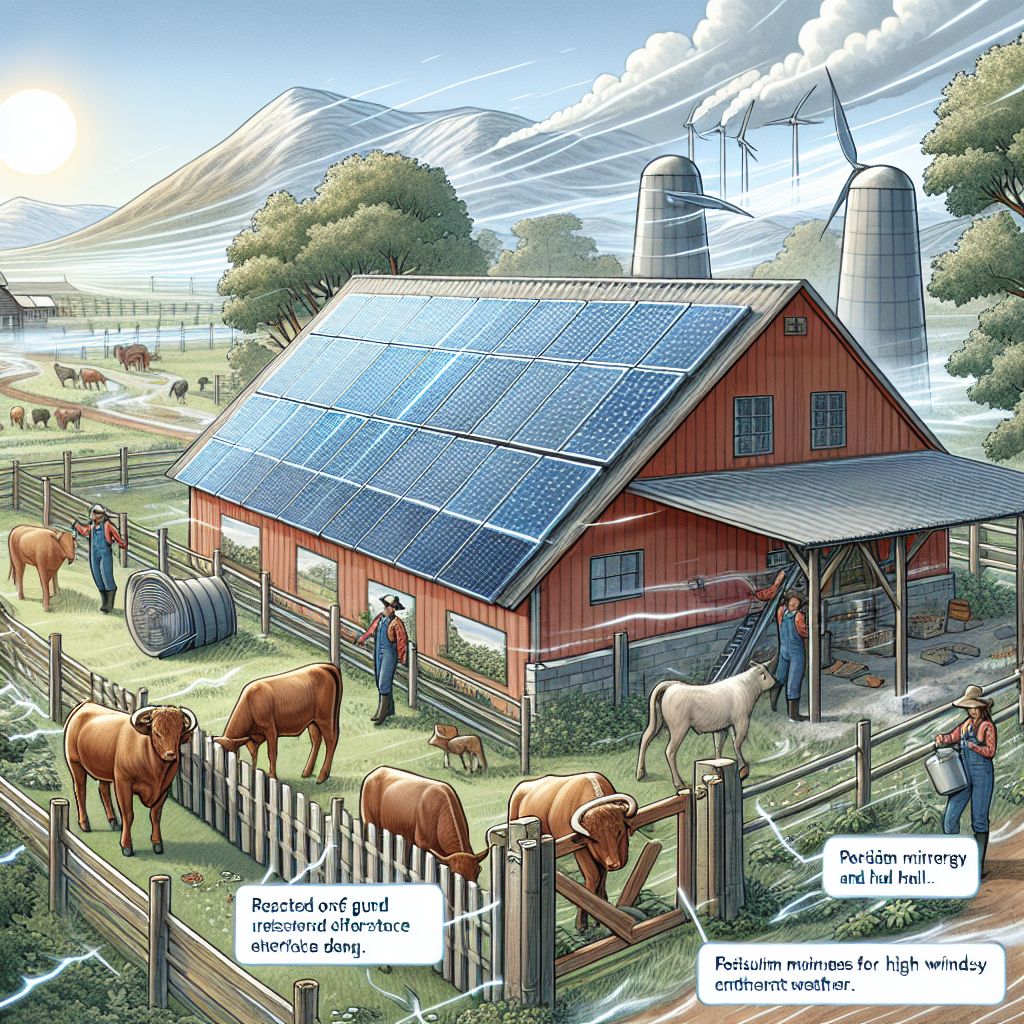
Addressing Issues: Shielding Panels from Livestock and Weather
Despite the obvious advantages of farm solar panels, there are potential obstacles to be aware of. Livestock may unintentionally harm panels, and severe weather conditions such as hailstorms or strong winds can be threatening.
How to Keep Solar Panels Safe from Livestock
It’s important to take steps to protect your solar panels from animals that might be curious or cause damage. This could involve putting up strong fences, raising the panels off the ground, or putting up barriers to keep animals away. Making sure the panels are out of reach will help prevent any accidental damage from livestock.
Reducing Weather-Related Threats
While weather is always a wild card, there are measures you can take to protect your solar panels. Opting for panels with a sturdy design, built to withstand high winds and hail, is a wise first step. Regular maintenance inspections can also help spot and fix any damage promptly, making sure your system stays up and running and efficient.
With careful planning and taking the right measures, you can reap the rewards of solar energy on your farm for many years to come, all while contributing to a healthier planet and more content livestock.
Solar Energy and Livestock: The Future of Sustainable Farming
With the sun as its power source, the future of farming is looking bright. Agrivoltaics, or the marriage of agriculture and solar photovoltaics, is leading us towards a more sustainable and efficient way of farming. By incorporating solar panels into livestock operations, farmers are forging a symbiotic relationship between energy production and animal husbandry. This integration not only boosts farm productivity and efficiency, but also promotes animal welfare and environmental sustainability.
Looking to the future, we can expect technology to continue evolving, making solar power even more appealing and advantageous for farmers. We’ll probably see solar panels become more efficient, which will make them more affordable and easier to incorporate into a range of farming activities. Also, as more farmers become aware of the possibilities, they will see that solar power can not only save them money, but also enhance the welfare of their animals and the condition of their land.
Thus, the combination of livestock and solar energy is a bright model of how innovation and tradition can cooperate. It’s a method that respects the past while accepting the future, making sure that farming continues to be a crucial and lively part of our planet.
Forecasts for Progress in Agrivoltaic Technology
As we look to the future, the progress in agrivoltaic technology is predicted to offer even more advantages to farms globally. Improvements in solar panel design may result in more robust, effective, and flexible systems that can endure the demands of farm life while maximizing energy output. We may also witness the creation of intelligent systems that can follow the sun’s path for ideal energy collection without interfering with farm activities.
Moreover, as solar technology becomes more common, the prices are expected to drop, making it a more viable option for farms of all sizes. This equal access to solar energy will enable more farmers to tap into the power of the sun, resulting in a greener, more sustainable farming industry.
Learning and Government Support
For solar energy to become a mainstream part of agriculture, farmers need to understand it. The more they know about the benefits and the logistics of solar panels, the more likely they are to use them. Education, through programs, workshops, and demonstrations, can give them the knowledge and the experience they need.
Moreover, farmers who are intrigued by the concept of solar energy will find the entry barriers significantly reduced thanks to government incentives. The initial costs of installing solar panels can be offset by tax credits, grants, and rebates, making it a more economically feasible choice. These incentives not only aid individual farmers, but they also contribute to the wider objective of building a sustainable and robust food system.
Final Thoughts:
Wrapping up, the use of solar panels in livestock farming shines a light on sustainable agriculture. It’s a progressive strategy that combines energy production needs with animal welfare and environmental health. As technology evolves and learning opportunities grow, we anticipate more farms will harness the sun to fuel their future.
Commonly Asked Questions
Before we conclude our discussion on farm solar panels and how they can enhance livestock productivity and efficiency, let’s tackle some typical inquiries that may come up.
How do solar panels boost livestock productivity?
Do solar panels pose a threat to livestock?
What’s the average payback period for farm solar panel systems?
How much land should I set aside for solar panels?
Are there any government incentives for installing solar panels in agriculture?
Knowing these factors can help farmers make educated choices about incorporating solar power into their farming practices.
How Can Solar Panels Improve Livestock Productivity?
By creating a more comfortable environment for the animals, solar panels can improve livestock productivity. The shade provided by the panels keeps livestock safe from extreme heat, which reduces heat stress and helps them maintain their appetites and growth rates. This can result in healthier animals and, as a result, increased production of milk, meat, or wool.
Are Solar Panels Dangerous to Livestock?
When installed correctly, solar panels are not harmful to livestock. On the contrary, they can improve the animals’ conditions by providing shade and reducing the need for cooling resources. It’s crucial to make sure that the panels are firmly fixed and that electrical components are safely enclosed to avoid any accidents.
How Long Does It Take to Recoup the Cost of Farm Solar Panel Systems?
The time it takes to recoup the cost of farm solar panel systems can fluctuate greatly depending on the size of the installation, the cost of electricity in the area, and available incentives. In general, farmers can anticipate a payback period of 5 to 10 years, after which the savings on energy costs will continue for the lifespan of the panels, which is typically 25 to 30 years.
What is the Land Requirement for Solar Panels?
The land requirement for solar panels is dependent on the energy requirements of the farm. A small-scale system might only need a small portion of an acre, while larger operations could require several acres. Solar panels can also be installed on rooftops or other structures, reducing the need for additional land.
Farm Solar Panels: Boosting Livestock Productivity & Efficiency. Installing solar panels on farms can provide multiple benefits, including reducing energy costs, increasing self-reliance, and minimizing the carbon footprint of farming operations. In some cases, solar panels can also improve the conditions for livestock, providing shade and reducing heat stress, which can lead to better growth and higher productivity.







Leave a Reply